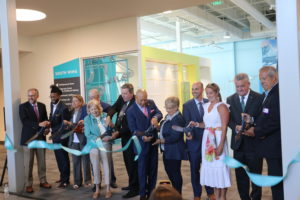By Jan Worth-Nelson

Ribbon cutters, l-r: Adam Falk, CEO, Sloan Foundation; Isaiah Oliver, president and CEO, Community Foundation of Greater Flint; Anne Saab, Flint Institute of Science and History board of directors; Hon. John Cherry; Linda LeMieux; Todd Slisher, CEO Flint Institute of Science and History/Executive director of the Sloan Museum of Discover/Longway Planetarium; Flint Mayor Sheldon Neeley; Debbe Campbell, director of development, Sloan Museum of Discovery; Ridgway White, president and CEO of the Charles Stewart Mott Foundation; Shannon White; Terry Rhadigan, General Motors VP Global Communications & Corporate Giving; Tim Herman, Flint Institute of Science and History board of directors. (Photo by Anne Mancour)
Three years after a groundbreaking at which a host of dignitaries foresaw local opportunities to champion science and history, the promise has been delivered. The newly renamed Sloan Museum of Discovery opened its doors to the public July 16 after a dramatic $30 million makeover.
Funded by a combination of grants, millions in contributions from philanthropic institutions, state funding and individual donations, the renovation almost doubled the size of the space, from 58,000 to 107,000 square feet and added four new galleries, a cafe, a full-service kitchen and expanded community spaces.
Gov. Gretchen Whitmer, who came in through a back entrance with her security detail, was at the top of the bill of speakers at the July 14 ribbon cutting.
“This is a great day for Flint,” Whitmer declared to an audience of about 25o. “From hands-on science and engineering experiences to a makers space featuring high-tech careers and skilled trades, this museum will inspire future innovators.”
She predicted the Sloan will “support jobs, uplift the local economy, and inspire future generations of Michiganders.”
“This expansion is yet another example of the fact that Flint — and Michigan — are on the move,” she declared.
Whitmer was joined on the podium by Todd Slisher, CEO and executive director of the museum; Ridgway White, CEO and president of the Charles Stewart Mott Foundation; Mayor Sheldon Neeley, Isaiah Oliver, president and CEO of the Community Foundation of Greater Flint (CFGF); John Cherry, Sr., chair of the Flint Institute of Science and History Board; philanthropist Phil Hagerman; Terry Rhadigan, General Motors VP of Global Communications and Corporate Giving; and others.
Thanks to the approval in 2018 of a county-wide arts millage which yields about $1.8 million a year to Sloan/Longway along with millions to other cultural institutions, Genesee County residents get in free. Spokespersons for the museum pointed out none of the millage money went to the renovations.
Additions include a new hands-on science gallery, called Discovery Hall, featuring a multi-story “Spaceship Earth” and an interactive water table to teach visitors about the Great Lakes.
The museum also includes a new Vehicle City Gallery, being renamed The Durant Gallery to honor General Motors founder Billy C. Durant and, through a $500,000 contribution from General Motors, supporting STEM exhibits and programs. That 11,000-square-foot gallery will feature rotating vehicles from the Sloan’s collection of 105 rare and vintage vehicles. GM already had donated $1 million to the renovation effort.
GM’s Terry Rhadigan described how Durant and J. Dallas Dort turned their carriage company into what is now one of the largest vehicle manufacturers in the world.
“Billy Durant was a fearless visionary who boldly seized opportunity wherever he found it,” Rhadigan said, “and the decisions he made changed the auto industry forever.” He predicted in the Sloan’s new era Durant’s spirit “will continue to inspire the next generation of entrepreneurs and STEM leaders.”
Durant’s great-grandson Duke Merrick of Virginia came to the opening to represent the Durant family.
An Early Childhood Gallery, called Hagerman Street acknowledging gifts from Flint’s Hagerman Foundation, aims to prepare kids for kindergarten through “play-centric exploration.”
Finally, a new History Gallery “showcases stories of Flint and Genesee County, as well as artifacts collected from the community.”
The aim of making the museum “an inclusive center for the entire community,” underwrote much of the renovation redesign. “This museum is literally being built from the ideas of our members, guests and the

Children enjoying the fishing and water hole at the re-made Sloan Museum of Discovery. (Photo by Tom Travis)
community at large,” Slisher said. One of many new features is a new community gallery “co-curated with local organizations on a rotating basis to showcase community-based exhibits.”
CFGF President Oliver highlighted those efforts in acknowledging “the Anishinaabe, Mississauga, and Sauk as the ancestral stewards of the land we are standing on today. We pay tribute to the elders both past and present in Flint, Michigan who have cared for this place,” he said.
He said the new era of the museum provides, “A fuller history. A deeper history. A history that is not being re-written. A history that is acknowledged.”
“A core purpose of our truth, racial healing and transformation work is to end the hierarchy of human value,” Oliver asserted. He said as viewers visit the new exhibits, “You will see new voices lifted up. Affirming voices with stories that are often left out. And a new exhibit focuses on our true historical roots among the Native Americans who created pathways before us.”
He said some of the museum’s changes reflect a larger attempt nationwide to tell more accurate histories “about the lives of Native Americans in exhibits, museums, and historical markers. And that is a reckoning with the truth that will take time,” he said.

The new entrance for the re-made Sloan Museum of Discovery. (Photo by Tom Travis)
According to Sloan’s Curator of Collections Geoff Woodcox, the museum has 47,511 three-dimensional artifacts, 34,391 photos; 5,179 books; 62,562 archival documents.
The original Sloan Museum opened in 1966 as the Sloan Panorama of Transportation, named for longtime General Motors President Alfred P. Sloan. Today it is supported in part by the Charles Stewart Mott Foundation, and the Michigan Arts and Culture Council. And its programs are additionally funded by Genesee County citizens through the support of what’s called the Arts Education and Cultural Enrichment millage, passed by county residents in 2018.
In the years of the renovation, the Al and staff moved into rented space in the Courtland Center Mall. That closed in May after three years to allow for the move back to the new space.
The museum opens at 10 a.m. Saturday and noon Sunday to the public. It is part of Flint Cultural Center campus, at 1221 E. Kearsley St., Flint. More information available at 810-237-3450, www.sloanmuseum.org.
Banner photo by Tom Travis
EVM Consulting Editor Jan Worth-Nelson can be reached at janworth1118@gmail.com.


You must be logged in to post a comment.